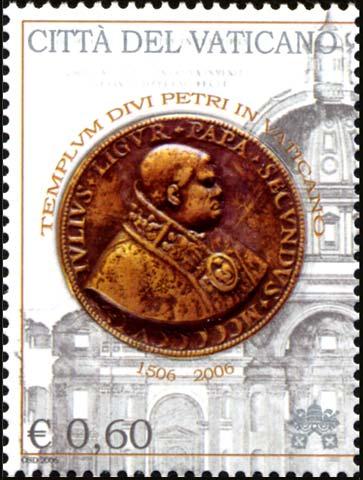
Home
 Pope Julius II Scott 1539 (2013) Pope Julius II was elected Pope in 1503. Born Giuliano della Rovere in 1443, he was one of the Church’s most influential Popes. He has been referred to as the Warrior Pope and the Renaissance Pope due to his efforts to restore the past glories of Rome in the early 16th century. To accomplish his goals, Julius first needed to regain control of Rome from the families that had turned the city into a mesh of gang-controlled sectors. He skillfully played rival families against each other and took control of the city. Once he had restored a more stable base, he was then able to begin the restoration of the city envisioned by one of his predecessors, Pope Nicholas V (who died in 1455). As a patron of the arts, he commissioned some of the greatest artists of the Renaissance era to work on the restoration of structures within Rome that has fallen into a state of decay. Bramante was commissioned to restore Saint Peter’s Basilica; Michelangelo, to create the magic of the Sistine Chapel; and Raphael, to grace numerous sites within Rome with his stunning frescos depicting scenes from the Catholic faith. He also extended his role as a patron of the arts through the establishment of the first Vatican Museum. It is safe to say that the Vatican as we know it today would not be what it is without the influence of Julius II. Following his death, Pope Leo X continued and expanded upon the works started by Julius. Julius the Warrior worked to restore the power and glory of Rome lost since the fall of the Roman Empire. In fact, he took his name not from the one previous pope named Julius (Pope Julius I, who died in 352 AD), but rather from Julius Caesar. Julius established political leagues to widen the political influence of the Papal States, first by securing southern Italy from the Venetians and then by removing influences from other European states, particularly France. He deftly shifted alliances in the formation of the leagues to accomplish his goals. During his time, he also established the Swiss Guards as the protective army for the pope in 1506. Pope Julius II died in 1513, but prior to his death he had commissioned Michelangelo to create a grand tomb in his memory. The scaled-back tomb, completed in 1545, includes the spectacular statue of Moses and is located in San Pietro in Vincoli, a minor basilica in Rome. However, Julius is buried, fittingly, at the Vatican in Saint Peter’s Basilica.   |